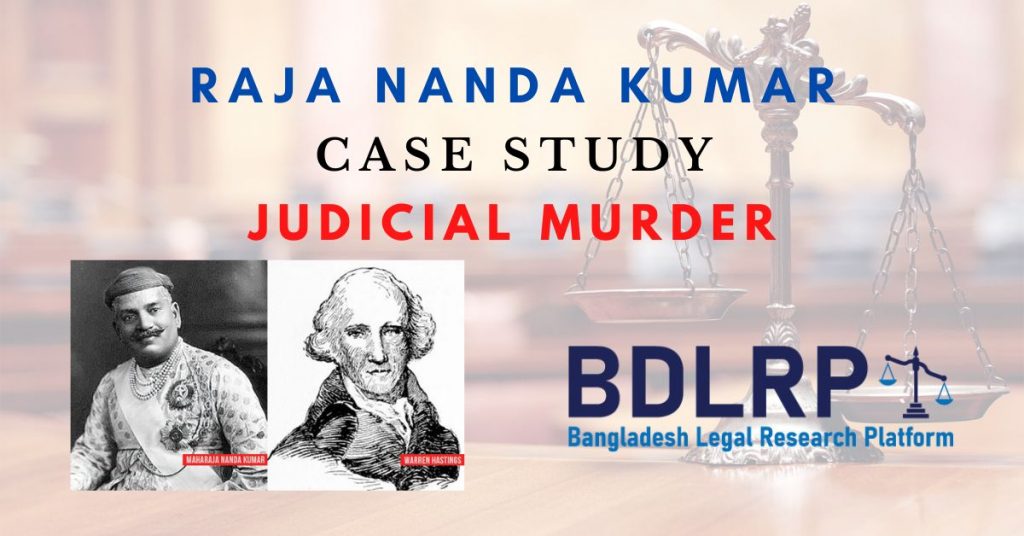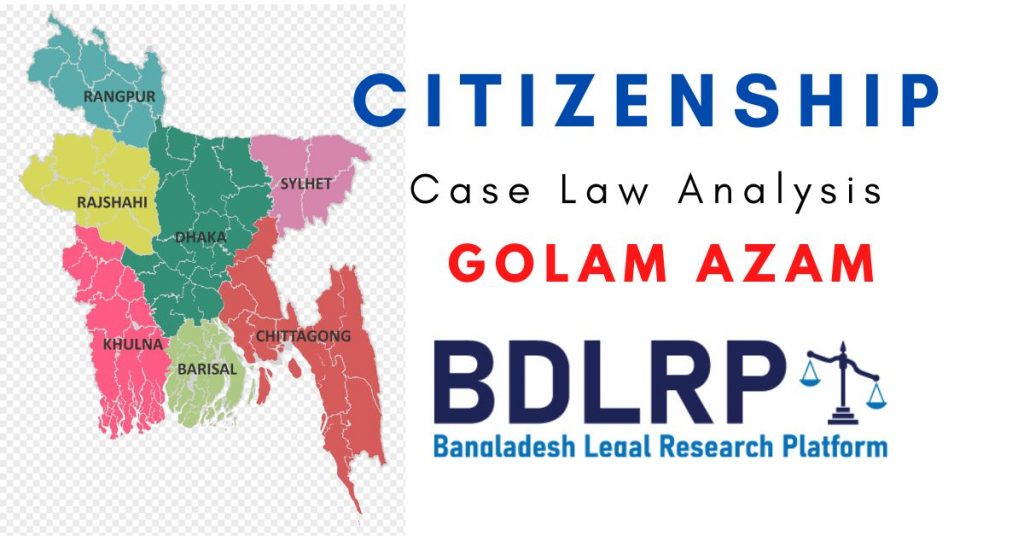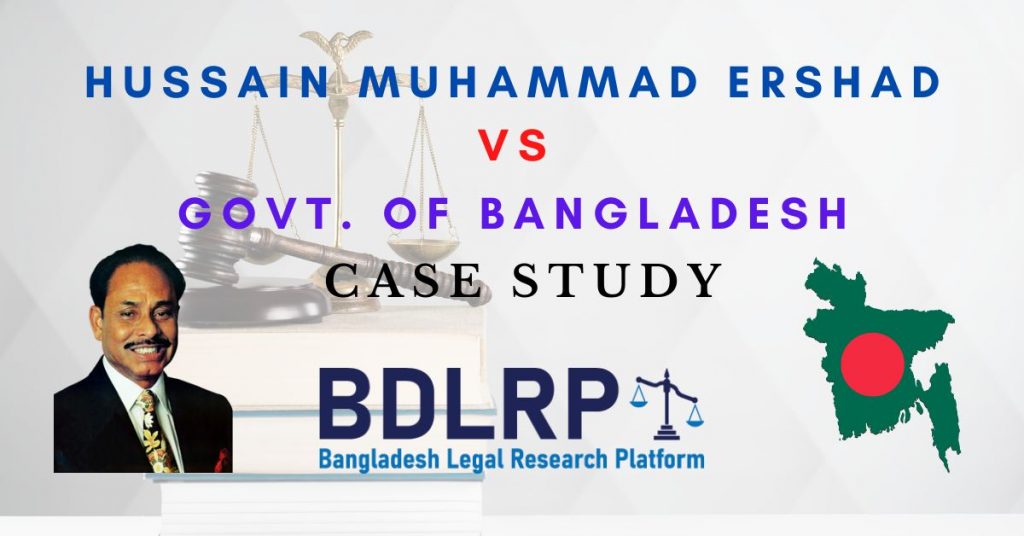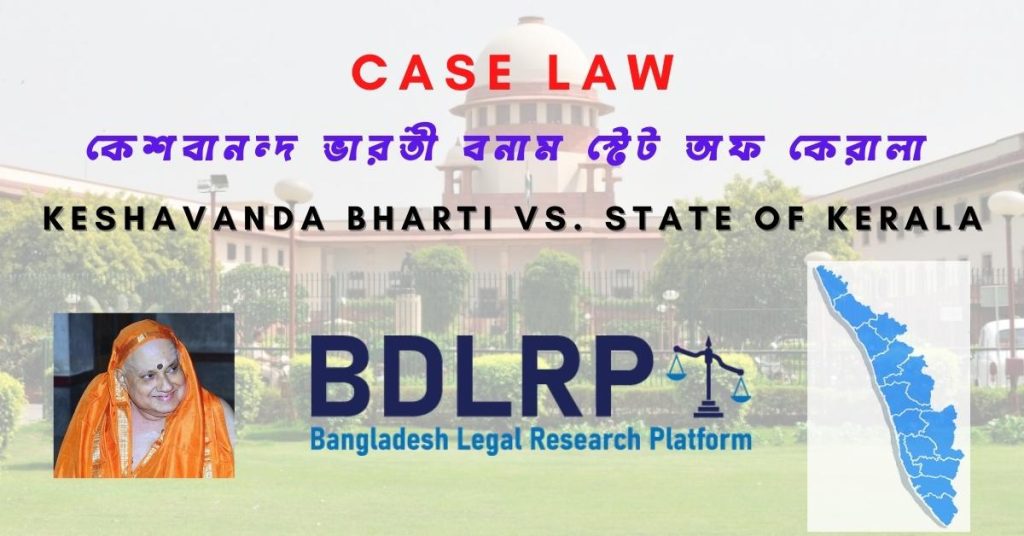Introduction:
Judicial killing or judicial murder is a common concept in modern society. Judicial murder is the intentional and premeditated killing of an innocent person by means of capital punishment; Therefore, it is a subset of wrongful execution. Innocent people is killed through a judicial process. (britannica.com, n.d.)
We are familiar with the word judicial murder in this subcontinent as well. Whenever we bring up this concept, a case comes up. That is the case of Raja Nanda Kumar. This is called the first judicial murder in the subcontinent. In this article, I will give a detailed description of it from the point of view of law.
Background of the case:
Maharaja Nandakumar was an Indian tax collector for various regions in what is modern-day West Bengal. Nanda Kumar was born at Bhadrapur, which is now in Birbhum. He was once a Governor of Hugli under Nawab Siraj-Ud-Daulah in 1756. He was very loyal to the English Company and because of that he was also known as Black Colonel during Clive’s period. He was the first Indian to be executed by hanging. Nandakumar was appointed by the East India Company to be the dewan (tax collector) for Burdwan, Nadia and Hoogly in 1764, following the removal of Warren Hastings from the post. (Gandhi)
In 1773, when Hastings was reinstated as governor-general of Bengal, Nandakumar brought accusations against him of accepting or giving bribes that were entertained by Sir Philip Francis and the other members of the Supreme Council of Bengal. However, Hastings overruled the council’s charges. Thereafter, in 1775, he brought charges of document forgery against Nandakumar. The Maharaja was tried under Elijah Impey, India’s first Chief Justice, and friend of Warren Hastings, was found guilty, and hanged in Kolkata on 5 August 1775.
Facts and procedures:
Raja Nanda Kumar was arrested with Fawkes and Radhacharan for the conspiracy at the instance of Governor General and Barwell. Warren Hastings and Barwell declared their intention before the judges of Supreme Court to persecute Nanda Kumar, the Fawkes and Radhacharan for conspiracy.
The trial of Nanda Kumar for conspiracy continued together with another trial of his forgery. Fawke was fined for conspiracy case but judgement was reserved Against Nanda Kumar on account of forgery case.
The charge of forgery against Nanda Kumar came before the Supreme Court in May 1775, with respect to a bond or deed claimed as an acknowledgment of debt Bulaki Das and that was executed by him in 1775. Mohan Prasad brought a charge of form on 6 May 1775.
On 7 May 1775, Mohan Prasad passed a bond To persecute Nanda Kumar in the Supreme Court. On the basis of it, the trial of Nanda Kumar began before the Chief Justice and three puisne judges of the Supreme Court on May 1765. Out of the twelve members of the jury, two were Eurasian and remaining were Europeans having resided since long in the town of Calcutta.
The trial of Nanda Kumar began on 8 June 1775 and continued for a period of eight days without any adjudication. The Court sat every day from 8 a.m. and witness were examined till late at night.
Documents, statements and accounts were in different Languages which were gradually being translated into English from the benefit of the judges.
The trial continued till midnight of 15 June 1775. On 16 June, in the morning, Impey CJ summed up the whole case. The judges gave unanimous verdict of “guilty” and the jury also declared the verdict of “guilty”.
Chief Justice rejected all the defence and passed death sentence of Nanda Kumar under an act of British Parliament, that was passed in 1729.
Laws related to the case:
The verdict in this case was based on a law passed by the British Parliament in 1829. It was part of British law and was effective for Britain. A review of the background of this Act shows that: –
In 1728 a sensational forgery case created headlines all around Britain. William Hales, a respected goldsmith, was convicted for forging several promissory notes that cost some very important people, including several parliamentarians, thousands of pounds. This case was punished in the usual way—Hales was pilloried, fined, and imprisoned.
1. To the people of London, the magnitude of his crime deserved a more severe punishment; many thought he should have received the death penalty. Ironically, they got their wish when Hales died in prison, probably of goal fever.
2. This case highlighted the vulnerabilities of Britain’s newly formed paper based credit system and economy. The changes brought about by the financial revolution in Britain under William of Orange and the Hanoverian monarchs made forgery easier to commit and disguise.
As a result, in 1729 a forgery statute was presented and passed by Parliament, declaring that anyone caught forging any Deed, Will, Testament, Bond, Writing-Obligatory, Bill of Exchange, promissory Note for Payment of Money, Indorsement or Assignment of any Bill of Exchange, or promissory Note for Payment of Money, or any Acquittance or Receipt, either for money or goods with intention to defraud any Person whatsoever, knowing the same to be false, forged, or counterfeited every such Person, being thereof lawfully convicted, shall be deemed guilty of Felony, and suffer Death as a Felon, without Benefit of Clergy. (Hamoen)
Looking at the background of the law, it can be seen that the law was made to solve the problems of Britain’s own country. It is in no way compatible with the Indian subcontinent. There are some problems with this law for its application in the Indian subcontinent. Neither the British Crown nor the Company had any jurisdiction to enforce this law in the Indian subcontinent. The Supreme Court did not have jurisdiction over this law.
Misdeeds and Defaults of This Case in Legal Perspective:
In this trial, two very important questions emerged. The first, whether the Supreme Court had jurisdiction in this matter?
Second, whether the English Act of 1729, which made forgery a capital offense, was extended to India?
The prime objection regarding the Supreme Court’s jurisdiction was that before the establishment of the Supreme Court in Calcutta, the Indians in Bengal were tried by local Faujdari Adalats. In this case, the offense was committed before the establishment of the Supreme Court, and therefore it had no jurisdiction to decide the case.
On the second issue of applicability of the Act of 1729 to India, there was a divided opinion even amongst the judges, but ultimately the majority views including that of the Chief Justice Impey prevailed.
Thus, the decision of the Supreme Court, in this case, created a huge controversy and depicted the arbitrary state of the administration of justice in India. This decision was widely criticized and popularly referred to as judicial murder of Raja Nand Kumar.
Documents, statements and accounts were in different languages which were gradually being translated into English for the benefit of the judges. With the new Supreme Court, it was difficult for people to understand these procedures. English was a new language for the people of this region in which it was not right to do justice. It raised enough questions about the quality of justice at the time.
Another peculiar feature of the trial was that the judges cross-examined the defence witnesses in a minute detail and thus they carried out the work of the prosecuting counsel on the plea that Kings Council was incapable of doing if efficiently. It creates serious doubts and suspicions about the impartiality of the Judges. The defence council decided to take an appeal to the King-in-Council and petitioned the court to stay the execution of sentence as long as the Council’s decision was not known. The court refected the petition. Efforts were also made to seek the assistance of Members of Council but all efforts proved in vain.
Ex-post-facto Law:
Ex post facto law, law that retroactively makes criminal conduct that was not criminal when performed, increases the punishment for crimes already committed, or changes the rules of procedure in force at the time an alleged crime was committed in a way substantially disadvantageous to the accused. (www.wikipedia.org, n.d.)
Even if Raja Nanda Kumar had committed the crime, he did so in 1765, long before the establishment of the Supreme Court. In his mind, it was an ex-post-facto law. This law is by no means effective in Bengal. As a result, whatever they do with the law will not fall into the system.
Reasons Behind Calling Judicial Killing:
Warren Hastings and Impey CJ were childhood friends. They had a good relationship.
King Nanda Kumar, on the other hand, was an enemy of Warren Hastings. He had to pay a fine for Nanda Kumar.
This trial is arranged according to Warren Hastings. The trial was held here for eight consecutive days which does not fall under any rules.
This judicial function does not fall within the jurisdiction of the Supreme Court. This trial was supposed to be in the district court but it has been in the Supreme Court which is outside the rules.
The defense was not given the right. Everything was done against them.
The law that was tried is not for the subcontinent. That was the law of Britain. This law is never supposed to be applied in Bengal.
It is said that the crime was committed before the establishment of the Supreme Court. Then it should not be considered a crime at that time. Then it has been judged by the ex-post-facto law. Which is not right in any way.
They gave no applied jurisdiction. They gave no chance to petition in King-in-council England.
Overview:
Based on all the evidence, it can be said that it is a Judicial Murder. Warren Hastings abused his power and killed Raja Nanda Kumar using the Supreme Court as a tool.
Conclusion:
Judicial Murder is a big problem. Looking at the Raja Nanda Kumar case, it is understood that there can be various problems for judicial issues. Innocent people can be punished for these judicial problems. These problems can be identified by the case of Raja Nanda Kumar. It originated in this case during the English period which still exists today. Knowing from the Raja Nanda Kumar case, we have to be engaged in trying to overcome the problems of the existing law.
REFERENCES
(n.d.). Retrieved from britannica.com.
(n.d.). Retrieved from www.wikipedia.org.
Gandhi, B. (n.d.). Landmarks in Indian Legal & Constitutional History.
Hamoen, C. (n.d.). Forgery: Legislation Gone Mad or Legitimate Social Threat? Oxford University Press.

Author: Md. Arman Khan
Law Discipline,
Khulna University.





Comments are closed.